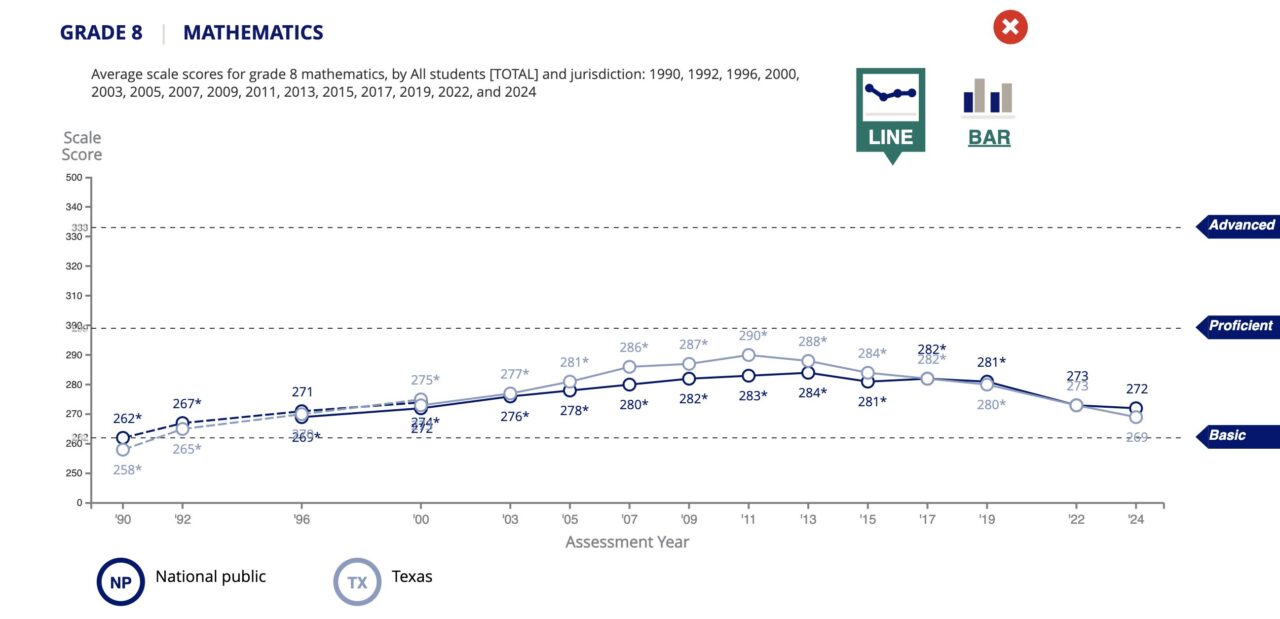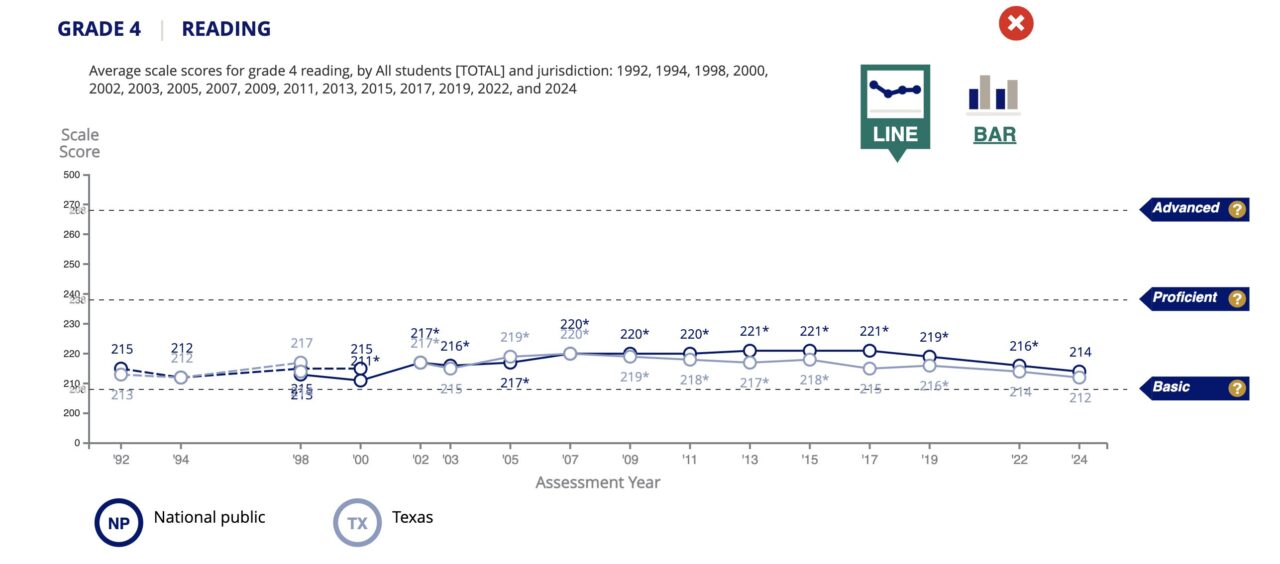
Democrats for Education Reform Texas Statement: Texas NAEP Scores Reveal Alarming Gaps in Student Proficiency
AUSTIN, TEXAS – Today, the National Center for Education Statistics (NCES) released the 2024 National Assessment of Educational Progress (NAEP) results, a common yardstick for measuring student reading and mathematics proficiency nationwide. By providing an apples-to-apples comparison across states, NAEP offers critical insights into learning gaps and educational progress, helping to inform statewide policy decisions, including in Texas during its ongoing legislative session.
The latest NAEP results reveal troubling trends in Texas, particularly in 4th grade reading and 8th grade mathematics. Texas students are lagging behind pre-pandemic levels. The latest data shows that the percentage of 4th and 8th graders performing ‘below basic’ proficiency in reading is the largest it’s been in at least 20 years. In Texas, 8th grade math scores are three points lower than the national average, placing Texas in the bottom third of the nation. Today’s results make clear: we have a statewide literacy and numeracy crisis.


Source: U.S. Department of Education. Institute of Education Sciences, National Center for Education Statistics, National Assessment of Educational Progress (NAEP), 2024 Reading Assessment.
The results are a sobering reminder that our state’s public education system is suffering from a lack of investment and prioritization from policymakers. This is a wake-up call for the urgent need to prioritize education reform. There are examples of success across the country– even next door to Texas. States like Louisiana, which have adopted proven science of reading policies, have seen students surpass pre-pandemic achievement levels. Similarly, Alabama’s 4th grade math scores exceeded pre-pandemic levels after significant legislative investment in math education in 2022.
With the Texas Legislature now in session, lawmakers have both the opportunity and responsibility to address this growing crisis. By investing in our public schools, passing evidence-based reading and math policy reforms, ensuring strong accountability systems, and supporting high-quality educators, Texas can turn these trends around, achieve the same progress other states have demonstrated is possible, and ensure our children are set up for a lifetime of success. A strong economy needs a strong workforce, and a strong workforce needs strong life skills. By prioritizing education, we can not only secure brighter futures for our children but also ensure Texas remains one of the strongest economies in the nation.
Moving Forward…
Presently, the release of the 2024 NAEP scores will continue to have extensive implications for Texas’ education policies, underscoring both the challenges and opportunities that lie ahead to continue closing achievement gaps. In 2025 and beyond, DFER TX remains committed to advocating for policies that prioritizes student success, increases school funding, invests in early learning, bolsters teacher pay, ensures accountability measures, and more. By tracking critical legislation and collaborating with stakeholders, we aim to ensure every Texas student receives a high-quality education for a lifetime of success.
If you have questions about these results or would like to discuss policy opportunities to improve student success, contact us at info@dfertx.org.
Understanding the NAEP
NAEP Results Here
What is NAEP?: Here
NAEP Assessment Details Here
Who Selects Tested NAEP Subjects Here
NAEP Report Schedule Here
How to Read NAEP Results Here.
Easily Explore NAEP Data Here
How Texas aligns to NAEP Scoring Here.
How NAEP Shapes Texas Education Policy Here
2022 vs. 2024 NAEP Results
- Overall Texas Average Score Changes Since 2022
- Grade 4 Reading -2 points
- Grade 4 Math +2 points
- Grade 8 Reading -3 points
- Grade 8 Math -4 points
- Percentage at or Above NAEP Proficient
- 2024 Texas | Nation
- Grade 4 Reading: 28% | 30%
- Grade 4 Math: 43% | 39%
- Grade 8 Reading 25% | 29%
- Grade 8 Math 24% | 27%
- 2022 Texas: | Nation
- Grade 4 Reading: 30% | 32%
- Grade 4 Math: 38% | 35%
- Grade 8 Reading 23% | 29%
- Grade 8 Math 24% | 26%
- 2024 Texas | Nation
Implications
- State Investments
- Even with $190B in federal relief funds, scores nationwide decreased nationwide in reading. These declines are particularly unsettling due to the long-term implications on lifetime earnings and the state’s economic growth.
- Each state’s 10-year trends suggest that a fundamental education system reset is needed to prioritize student outcomes, otherwise the possibility of student recovery remains slim. NAEP’s scores serve as a reminder that state investments and prioritizations are crucial to academic success.
- NAEP & STAAR Confirm Urgent Need for State Investment
- The 2024 NAEP results also reflect fears from STAAR assessment results, which indicate COVID-19 pandemic learning loss continues to remain. Though STAAR and NAEP are uniquely different assessments, their trends align. Both suggest that although early education supports are modestly working, recovery efforts are urgently needed for students in older grade levels.
- Greater Score Decline for Lower-Performing Students
- NAEP is scored at 5 selected percentiles to assess progress made by lower, middle and higher performing students. The results from 2022 revealed a decline in reading and math at all percentiles. For both subjects, lower performing students declined even more drastically than higher performing students. This trend continued for 2024, with scores for both reading and math increasing in grade 4 and 8 for higher-performing students, while lower-performing students declined or remained the same. These trends reflect the disproportionate impact of COVID-19 learning loss on students with pre-existing academic challenges.